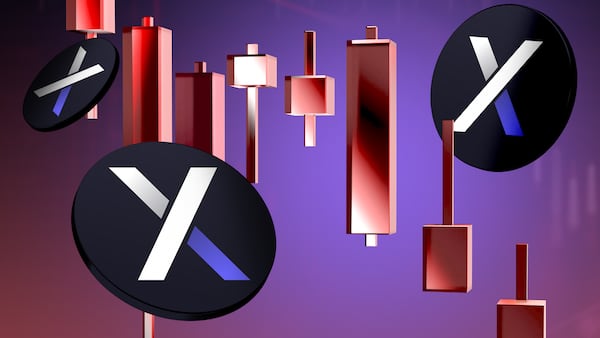- Fluid’s decentralised exchange is gaining traction.
- Trading volume hit a new high this week.
- The project’s roadmap includes improvement and expansion.
Uniswap may still be one of DeFi’s top dogs, but a rising rival is closing the gap.
Fluid, a DeFi protocol with lending and a decentralised exchange, is closing in on Uniswap after notching record trading days over the past week.
Fluid briefly passed Uniswap in daily trading volume on Ethereum, handling almost $1.5 billion in volume on Sunday — a record high for the two-year-old protocol. This comes slightly above Uniswap’s $1.3 billion in volume that day.
Measured by trading volume, Uniswap has been the top decentralised exchange on Ethereum since its launch in 2018, being passed only once briefly by dYdX in January 2024.
While Fluid has gained traction, Uniswap still commands over 60% of weekly trading volume on Ethereum-based decentralised exchanges, according to Dune data.
Throughout 2025, Fluid and Curve battled for the second spot, with Fluid eventually overtaking Curve. As of Monday, Fluid accounted for about 21% the prior week’s trade volume.
On Saturday, Fluid overtook Uniswap in terms of stablecoin volume, having a 55% market share across Ethereum, Base, Arbitrum, and Polygon, according to Dune data.
Launched in 2023, Fluid provides lending and swapping services. It was founded by a team that previously created Instadapp, a middleware platform that helped develop features for some of the largest DeFi projects, such as Aave, Uniswap, and Curve.
Deposits into Fluid have grown 40% year-to-date to over $1.4 billion, according to DefiLlama.
Fluid’s key feature is its so-called liquidity layer, which serves as a foundation for other protocols to launch on. It aims to solve liquidity fragmentation, one of the biggest problems in DeFi.
When a protocol launches, it has to find ways to attract liquidity, including by distributing its native token as an incentive. Even with incentives and superior features, however, a protocol might struggle to attract substantial liquidity.
To solve that problem, Fluid allows protocols to be built on top of its liquidity layer. When users move assets from one protocol to another, they enjoy the same amount of liquidity.
“Liquidity Layer minimises capital fragmentation and maximizes the potential for liquidity utilisation across protocols, ultimately driving greater value for users,” says Fluid in its documentation.
Additionally, Fluid’s liquidity layer automatically adjusts the collateral ceiling when funds are reaching borrowing limits. This feature restricts sudden large withdrawals or borrows, giving developers time to react in the event a protocol is hacked or exploited.
Currently, there are three protocols — lending, vaults, and a decentralised exchange — built on top of the liquidity layer, with more planned in the future.
Fluid’s lending protocol allows users to lend Ethereum and other stablecoins to earn yield.
Fluid also offers capital-efficient borrowing and gas-efficient liquidation mechanisms with its vaults product, allowing users to borrow up to 95% of their collateral.
Fluid’s decentralised exchange
Fluid’s decentralised exchange became the fastest growing exchange on Ethereum, reaching $10 billion in cumulative volume in just 100 days, 24 fewer days than the second fastest, Sushiswap.
Since the exchange is integrated with the lending platform, lending fees are directed toward borrowers, and users can turn their collateral and debt into trading liquidity, lowering the cost of capital to borrow.
Currently, Fluid’s decentralised exchange offers mostly assets that are closely correlated, such as stablecoins and cryptocurrencies such as Bitcoin and Ethereum.
Alex Cutler, co-founder of competing liquidity protocol Aerodrome, said that “the measure of a [decentralised exchange] is its ability to capture and redistribute value.”
“Fluid has a solid niche in the [decentralised exchange] space by reducing cost per unit of yield in correlated assets, but the reason most [decentralised exchanges] don’t focus there is because it’s the lowest margin business line for an exchange,” said Cutler.
He pointed out that users have already lost over $20 million in an Ethereum and USDC vault, according to Dune data. The team plans to cover this loss by vesting 500,000 Fluid tokens, worth about $2.7 million on Tuesday, to make up for the loss.
But Fluid co-founder Samyak Jain said that most of this loss was due to users leveraging Ethereum at a high price, and the $20 million number is inaccurate, although he did not state the total amount lost.
In response to Fluid passing Uniswap in Ethereum trading volume, Jain said “while it’s a great achievement for Fluid, I think the real win will be when Fluid is able to compete on the volatile pairs & fees.”
Fluid’s token hit a record high of about $375 million in market value in December, though it has since dipped to $215 million.
In April, the team announced upgrades to Fluid’s decentralised exchange, additional protocol launches on top of the liquidity layer, a future launch on Solana, and the integration of real-world asset and foreign exchange markets.
Fluid also plans to release the “lite” version of its exchange, which it claims will be the “most gas efficient” exchange on Ethereum. Jain said that he expects this upgrade will add $400 to $600 million in daily volume.
Zachary Rampone is a DeFi correspondent at DL News. Have a tip? Contact him at zrampone@dlnews.com.








